| Home>Myth>Article |
Munasukihime who saved Izumo
The following text is a slightly modified machine translation and may have some unnatural parts.
==Introduction==
There is a legend of Munasukihime or Tagorihime in Gotsu City, Shimane Prefecture. It is based on the Yokyoku (Noh) "Misaki" and can be traced back to the medieval Izumo myth. In addition, it corresponds to the prequel of Kagura "Jura" and "Hinomisaki", but the story casts a shadow on the character of the princess. Arranged in chronological order in which the original legends are recorded, the order is Hinomisaki Shrine's biography, the Yokyoku "Misaki", Article of Susa of "Kaikitsu-dan", and "Iwami Yae Mugura". It is speculated that the legend of Susa is older than "Misaki" and may have become the source of "Misaki".
==Synopsis==
A long time ago in the gods, a little girl on an ark arrived at the present Hashi Beach. She seems to be a child of a noble family from the appearance. She was picked up and raised by an old man and an old woman. The princess grew up in good health, but she didn't answer whatever she asked. When asked where she came from, she only points east. Without helping the old men and old woman, she spent all her time practicing bow and arrow. One day, when she saw a signal fire rising in the eastern sky, she finally revealed her identity. She was Tagorihime who was swept away by the rage of her father Susanoo because her heart was so rough when she was young. Izumo is struggling to be attacked by a country called Jura. She was told of Susanoo's dream that Izumo would win if Tagorihime returned. The princess leaves Iwami to fight the enemy attacking Izumo, and she returns to Izumo. The old man and the old woman who were sad about it chased after the princess, but the princess hid in the shade of the rock and passed her old men. The old man and the old woman who lost sight of her princess were exhausted and died on the coast of Asari. After returning to Izumo, Tagorihime immediately repelled the soldiers of Jura. She was given the name of the Jurasetsunyo (Ten Rakshasa).
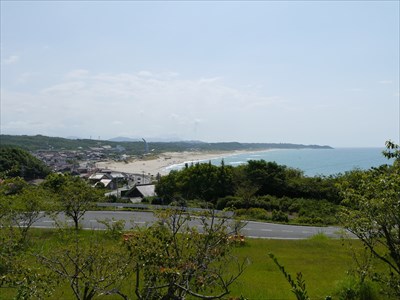
Hashi Coast
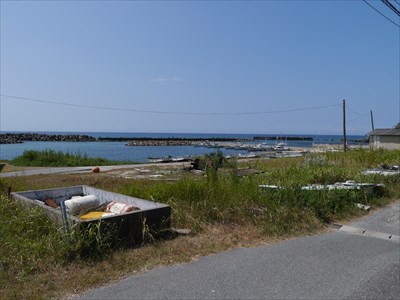
Hashi Coast
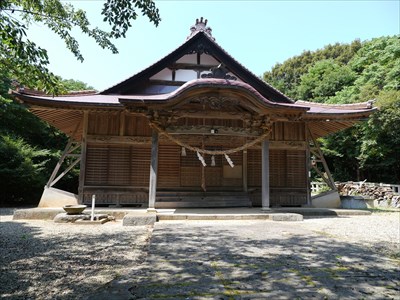
Tsuto Shrine

SononoMyokenHayashi Shrine. Hayashi means fast feet.
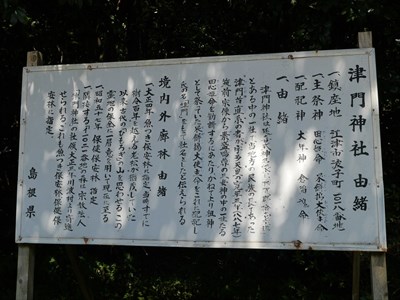
History of Tsuto Shrine
The name of the Ten Rakshasa appears here, but think of it as the Jurasetsunyo who have syncretized goddess and ten Rakshasa with one goddess, not the ten Rakshasa in Buddhism. It is a popular theory that the child born of Susanoo with a dragon maiden is a Jurasetsunyo.
Tagorihime is another name for Takiribime. The goddess appears in Kiki mythology.
The above synopsis is a summary of the legend "Tagokorohime who saved Izumo" recorded in the "Legend of Shimane" that Nihon Hyojun had published. Ruby is applied as "Tagokorohime", but this is probably a misrepresentation of "Tagorihime". The Hayashi Shrine, where the princess is enshrined, is located within the precincts of Tsuto Shrine, and the deity of Tsuto Shrine is Tagorihime.
It is recorded as a legend of Munasukihime in "Naka-County magazine" and "Naka-County history" by Ikutaro Oshima. The content is almost the same as "Legend of Shimane", and it describes that the princess pointed to herself and said "a", and that she changed her chopsticks every time she ate.
This legend is recorded in the article of Hashi in the Edo period geography book called "Iwami Yae Mugura".
It is also a legend related to Iwane Shrine in Kakushi-town, Gotsu City. A hidden rock is enshrined outside the precincts where the princess hid herself. When I actually look at it, I get the impression that it is finally possible to hide one child with a small rock.
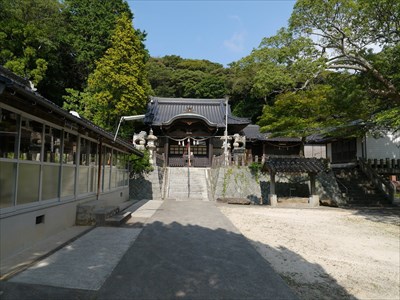
Iwane Shrine
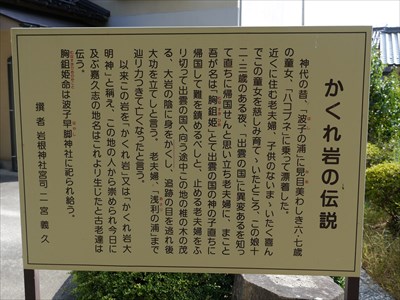
Legend of Munasukihime
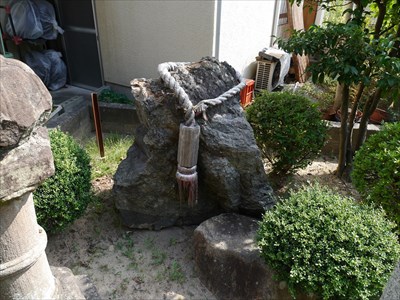
The Hidden Rock
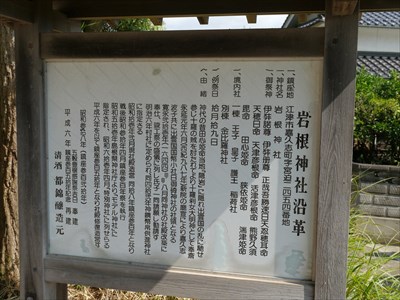
The History of Iwane Shrine
It is recorded in the Gotsu City magazine under the title of "Grandpa Well / Grandma Well (Asari)". It is similar to the content of Naka-County magazine replaced with modern language, but it is said that the tears of sadness of the old man and old woman who left the princess at the end accumulated in the hole at the hillside of Kousen of Mt. Asari Fuji.

Grandma Well

Grandma Well
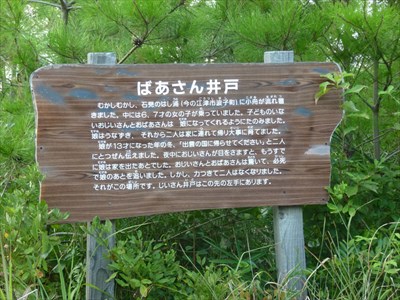
Legend of Grandma Well
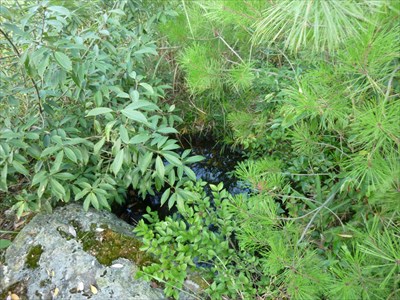
Grandpa Well
==The biography of Hinomisaki Shrine==
The oldest legend is the tradition of Hinomisaki Shrine in Izumo City. According to it, a long time ago, the evil god of the Gesshi country came on a huge ship with a sharp weapon. The spear did not hit. He wanted to recapture the old territory of Mt. Arachi. At that time, our god flew and wielded a spiritual sword to show courage. The enemy soldiers drifted and sank in the sea. This is the story of Emperor Korei's time. Since then, the god of foreign defense has always been ...

Hinomisaki Shrine
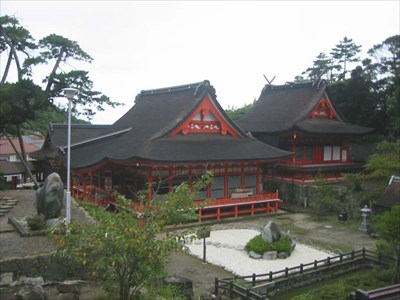
Hinomisaki Shrine
This is a letter of solicitation written in 1420. The name of the goddese does not appear here, but it is written that the deity of Hinomisaki Shrine prevented foreign enemies.
In 1419, the previous year, Oei Invasion occurred. This is an invasion of Tsushima island in the name of subduing Japanese pirates, but it can be said that it had a big impact at that time because there was a rumor that Ming would attack.
It says, "I want to recapture the old territory of Mt. Arachi." To explain this background, the northeastern corner of Mt. Meru was missing in the time of god. It has washed ashore in Izumo. God solidified it and became Mt. Arachi. The situation is that a demon has attacked from the Gesshi country in an attempt to recover it. The story that a corner of Mt. Meru was washed ashore in Izumo and was solidified by a god can be seen in the myth of Izumo in the Middle Ages. Originally thought to be from the Kunibiki myth of Izumo Fudoki, it incorporates a Buddhist view of the world.
There is also a legend that this god of Hinomisaki Shrine is Akehayazumi. Here, the god is Akehayazumi, but it seems that the story of the Jurasetsunyo was widely accepted as a legend.
Hinomisaki Shrine, which came out of the control of Izumo Taisha, created such a legend against Izumo Taisha and promoted the effectiveness of foreign enemy defense.
It is said that Tsuto Shrine and Iwane Shrine in Gotsu City were the territories of Hinomisaki Shrine, and the legend of Munasukihime may have been born in connection with this.
==Yokyoku"Misaki"==
The date of establishment of the Yokyoku "Misaki" is not clear, but it seems that it was established in the 16th century.
In the third volume of "Yokyoku Monographs", The cast table is as follows.
Shite: Emperor of Hikohane
waki: Susanoo
Tsure: Court
Child actor: Ichikishimahime
Tomo: servant
Locale: Izumo Province
The feature is that the princess is Ichikishimahime. In the Yokyoku "Misaki", the princess is not Tagorihime but Ichikishimahime. This is because she is described in the play as Susanoo's third daughter. Tagorihime and Ichikishimahime are both considered to be the Three Goddesses of Munakata, and were born when Amaterasu and Susanoo fortune-telled (Ukei: fortune-telling Susanoo's true intentions). She was made Susanoo's daughter because she arose from a bite of Susanoo's sword.
Roughly explaining the synopsis, Susanoo first appears, and Mongolia attacks Japan, so he says that he will try to prevent it. The northeastern corner of the Gesshi country was chipped off and washed ashore in Izumo. It is said that god solidified it and became Mt. Furo, and that the palace of god was established. The princess sneaked across Iwamigata-sea and came from Hashi to Tagi. A court appeared and guided the princess. She reunited with Susanoo, She said she was a child born between Susanoo and the Dragon King's princess. While Susanoo attended to the dragon maiden, the dragon maiden naturally became pregnant. When Susanoo wrapped the princess in Kashiwa leaves and sank it in the sea with the swords of Totsuka (Totsuka means ten handful), she washed ashore on the beach of Hashi. She said the fisherman couple found it and the childless couple decided to raise a princess. She says the princess is Susanoo's third daughter and she will be eleven years old this year. Seeing her sword of Totsuka presented by the princess, Susanoo was convinced that the princess was definitely his daughter. Her father and daughter had a parent-child relationship. At that time his servant reported that an enemy had attacked from a foreign country. The enemy attacked with a horde of 80,000, so allies who thought they couldn't win ran away. The princess says she will protect the enemies. The princess, who turned into a swan, drops a large rock on a ship and sinks it. And she wields the sword of Totsuka to shoot down her enemy's neck. and she turned into a Jurasetsunyo ...
At the stage of "Misaki", the elements of the legend are almost complete. It can be thought that the legend of Munasukihime was told from the line of sight of the old man and old woman who picked up Munasukihime.
Since there is Mongolia in the play, you can also see the influence of the Mongol invasion. In some scripts of the Shinnoh "Hinomisaki", the enemy is described as "Mukuri (Mongol)" and "Kokuri (Goguryeo)".
==Kaikitsu-dan==
In the legend of Munasukihime, "Kashiwa leaf" is casually mentioned. There is a geography book of Izumo written in the Edo period called "Kaikitsudan", and it is thought that it is based on the tradition recorded in the article of Susa.
Susa
According to an old priest, that is Mt. Orokoshi. This is called the Suga River, where the Rukawa flows to the side of the shrine. This river is called Rukawa because Susanoo wrapped his first daughter in the leaves of Kashiwa and let it flow into the river. There is a Kashiwa tree on the shore of Orokoshi. The shed goddess was washed away to Hashi coast in Iwami Province. The goddess is said to be worshiped as Hinomisaki today.
Since it is Susanoo's first daughter, it can be interpreted as Tagorihime.
It is probable that this was based on the tradition of "deciduous leaf of maki" related to Susa Shrine in Izumo City. It is a tradition that the afterbirth of Princess Inada was wrapped in Kashiwa leaves and flowed into the river.

Susa Shrine
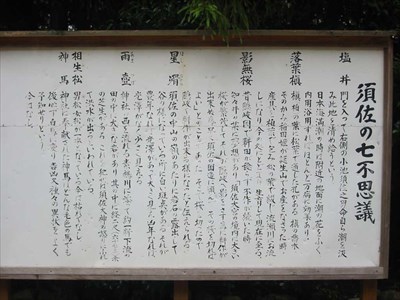
Seven mysteries of Susa
==Iwami Yae Mugura==
The legend of Tagorihime is also recorded in the Edo period geography book "Iwami Yae Mugura". Tagorihime's heart was so rough that she raged her father Susanoo and she was aboard a ship without a paddle and she was washed ashore in what is now Mikou. While she was staying at this port, a country called Jura attacked Izumo. Susanoo's dream told him that Izumo would definitely win if he recalled Tagorihime and made her a general. Tagorihime returned to Izumo, destroyed the enemy soldiers, made her work, and allowed her father's rage.
In "Iwami Yae Mugura", there is a description that the deity of Tsuto Shrine is Jurasetsunyo, or that it is Munasukihime. Tsuto Shrine is one of the Iwami Country Shikinai Shrines (the old and officially certified shrines), In the Edo period it was called the Jurasetsunyo shrine. In the Edo period, national studies became popular and Yoshida Shinto became popular, so it may be that the name of Munasukihime was conceived in order to dilute the Buddhist color.
==Kagura==
Iwami Kagura has a performance called "Jura". A demon named Hikohane attacked Tsushima island, but she was hit by a storm and barely arrived alive. Jurasetsunyo persuades Hikohane to return to her homeland, but Hikohane refuses and fights ...
Also, in Izumo Kagura's "Hinomisaki", a demon called Hinohari attacks, and Hinomisaki Daimyojin exterminates Hinohari. "Hinomisaki" is also called "Hikohari at dawn", and you can see that it is emphasized in Izumo Kagura as the last order.
Takatoshi Ishizuka, a folklore scholar in Izumo, attributed "Jura" and "Hinomisaki" to the Yokyoku "Misaki".
Since it is the Jurasetsunyo who appears in "Jura" and the Hinomisaki Daimyojin who appears in "Hinomisaki", its origin is abstracted ("Jura" says "Living in Gakuenji-Temple"), " The name of the demon of "Misaki" is Hikohane, so you can think that it is based on "Misaki".
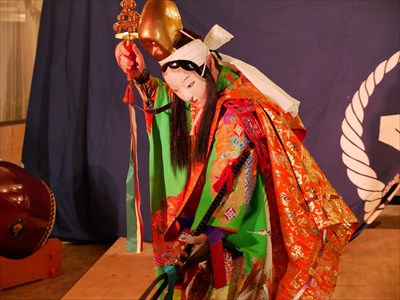
Iwami Kagura Jura

Iwami Kagura Jura
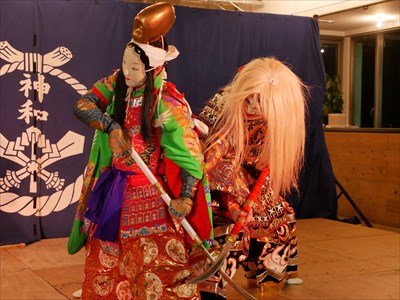
Iwami Kagura Jura

Iwami Kagura Jura
In addition, there is "Jurasetsunyo" in the Bingo Tojo Kojin Kagura Noh book (Enpo book) recorded in "Japanese People's Cultural History Collection Vol. 1 Kagura / Dance". This is considered to be the oldest Kagura Noh book related to the Jurasetsunyo, so in the latter half of the 17th century, the prototypes of "Jura" and "Hinomisaki" were completed.
==Who is Munasukihime==
In Gotsu City, the legend of Tagorihime and the legend of Munasukihime coexist. Perhaps Munasukihime is Tagorihime. In "Kaikitsudan", she is Susanoo's first daughter and can be interpreted as Tagorihime. Since Tagorihime was born from the tip of a sword, she is also called Kissaki Daimyojin. On the other hand, in the Yokyoku "Misaki", princess is the third daughter of Susanoo, so she refers to Ichikishimahime. However, in "Misaki", it is a child born between Susanoo and the dragon maiden, so it may be different from the Three Goddesses of Munakata born by Amaterasu and Susanoo's fortune-telling. In Iwami Kagura "Jura", Jurasetsunyo is the youngest child of Susanoo, and she will be different from the Three Goddesses of Munakata. In any case, the origin of the princess varies depending on the source, so it is not possible to determine who Munasukihime is. According to the materials of Hinomisaki Shrine, "OtomeMunasuki is another name for the Three Goddesses of Munakata", and it can be interpreted that the OtomeMunasuki is another name for Munasukihime. In other words, someone from the Three Goddesses of Munakata will be influential. Personally, the first story I read is that of Tagorihime, so I recommend the Tagorihime theory.
==Source of the Yokyoku "Misaki"==
"Kaikitsudan" was established in the 17th century. In chronological order, the formation of the Yokyoku "Misaki" preceded "Kaikitsudan", but it can also be considered that there was a legend that was the source behind the story of the Yokyoku "Misaki". In other words, it is possible that the tradition described in Susa's article in "Kaikitsudan" dates back to before the Middle Ages. Then, the relationship between "Misaki" and "Kaikitsudan" will be reversed.
Is this reading a bit too much? Is it natural to think that the conversion was done by taking in the deciduous leaf of maki as the source of the Yokyoku and wrapping the princess in Kashiwa leaves and letting it flow?
==Composition and narrative==
It can be said that the motif of picking up and raising a young princess washed ashore on the beach is derived from the Princess Kaguya motif. As a result of the Princess Kaguya motif, the princess returns to Izumo, but it is characterized by the narrative at the end of the story. The old man and old woman who followed her princess died on the coast of Asari. If it ends here, it will end as a sad story, but the legend continues, and it is said that the princess who returned to Izumo repelled the invaders and she was given the name of the Jurasetsunyo.
The old man and the old woman have died. Meanwhile, the princess repelled the invaders and Izumo became peaceful. Congratulations! And the story ends. It's a mysterious narrative.
Immediately after the sad motif of the death of an old man and an old woman, the princess repels the invaders, becomes peaceful, and ends with the victorious motif of Congratulations. The motif of the princess's victory comes next to the motif of the death of the parents. Doesn't this make you feel uncomfortable? It's a double closing. For that reason, the connection between motifs is uncomfortable, and this is a structurally difficult case.
To think about it, I will bring the story of the princess who brought peace to Izumo at the beginning of the story. And if the story is constructed in a reminiscence style of drifting to the beach from there, there will be less discomfort.
==Digression==
I remembered the legend of Tagorihime when I returned home in the summer of 2006 and noticed that "Legend of Shimane" that Nihon hyojun had published was left in my parent's house. "Legend of Shimane" was bought as an elementary school assignment book, and it had a dark and unique style. I took this book back to Yokohama and read it.
It turned out to be a legend of Hashi town, Gotsu City. When I searched on the net, I found a site that recorded the legend of Munasukihime. Perhaps the text was a reprint of the relevant text from "Naka County Magazine". The site has already been deleted.
I went to Masuda City Library in the summer of 2007. Here, I noticed that the legend of Munasukihime is recorded in "Naka County magazine". This is a sentence by Ikutaro Oshima.
I also actually visited Tsuto Shrine. The rocky shore behind the beach is a park, and there is a parking lot, but at that time I headed on foot from JR Hashi Station. After finishing the visit, I went to the park behind. On that day, the weather was mixed with light rain and fog was flowing from the sea, which made me feel mysterious.
I didn't go that day, but there is a lighthouse on the other side of the rocky shore. And from there you can see Iwamigata-sea. It is also the world of Manyoshu.
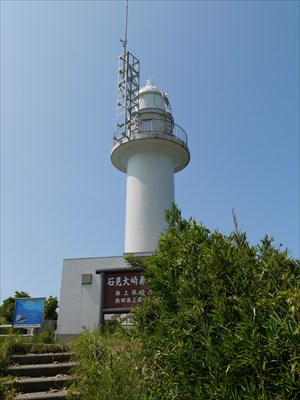
Osaki Hana Lighthouse
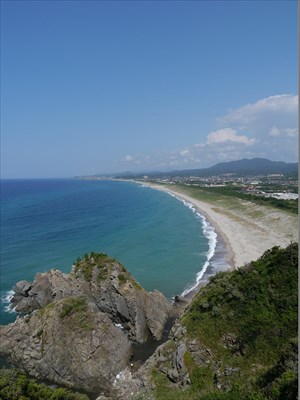
Iwami-Gata Sea
In the summer of 2008, I visited Susa Shrine and Hinomisaki Shrine. Izumo is so far away that I got tired just by going.
The materials were collected smoothly, but I couldn't find only Yokyoku "Misaki". In 2009, there were about 50 "Unpublished Yokyoku Collection" at the Yokohama City Central Library, and I asked them to put out all of them and confirmed them. After all, it turned out that the final volume was an index. Finally I was able to find "Misaki".
After that, it turned out that it was also recorded in the third volume of "Yokyoku Monographs", and the materials were ready.
In the Kanto region, there is a Jurasetsunyo small shrine at Jufuku-ji Temple in Nerima Ward. In addition, at Nagasaki Shrine in Toshima Ward, there is a hand water bowl engraved with Jurasetsunyo. Akatsuka Suwa Shrine in Itabashi Ward was also considered to be the Jurasetsunyo Shrine.
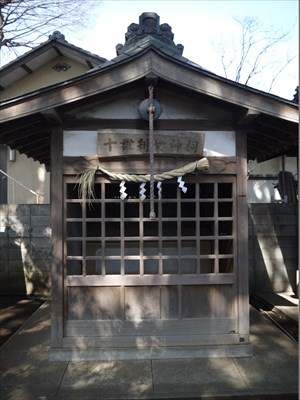
Jurasetsunyo small shrine at Jufuku-ji Temple
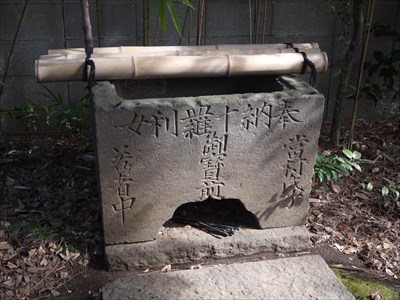
hand water bowl engraved with Jurasetsunyo at Nagasaki Shrine
In 2010, I climbed Mt. Asari Fuji. There was a parking lot on the hillside, and I walked along the approach from there. The Grandpa well was in the woods. I proceeded while squeezing through the spider's web. Then I returned to the approach and started climbing. However, I made a mistake and climbed the mountain quay. Since I was able to climb in light clothing, the slope was gentle, but I was exhausted after climbing a few tens of meters. After that, I went down the Kosen approach from the top. There was a Grandma well on the way. I sprinkled the water in the hole on Jizo, but the bee was wary of me. The bee had been following me for a while, but at some point the bee turned back, so I think that was the territory of the bees.
==References==
- *『島根の伝説』(島根県小・中学校国語教育研究会/編, 日本標準, 1981)pp.217-220
- *『那賀郡誌(復刻版)』(那賀郡共進会展覧会協賛会/編, 臨川書店大正5年発行, 1986)pp.74-77
- *『那賀郡史』(大島幾太郎, 大島韓太郎, 1970)pp.121-124
- *『謡曲叢書 第三巻』(芳賀矢一、佐佐木信綱/編, 博文館, 1915)pp.350-354
- *『謡曲全集 下巻 国民文庫』(国民文庫刊行会/編, 国民文庫刊行会, 1911)pp.321-325
- *『未刊謡曲集 続 14(古典文庫 第571冊)』(田中允/編, 古典文庫, 1994)pp.26-28, pp.192-204
- *「懐橘談」『続々群書類従 第9 地理部』(国書刊行会/編, 続群書類従完成会, 1984)pp.439-441, pp.442-443
- *『雲陽誌』(芦田伊人/編, 雄山閣, 1971)pp.226-227, pp.312-316
- *『角鄣経石見八重葎』(石見地方未刊行資料刊行会/編, 石見地方未刊行資料刊行会, 1999)
- *『式内社調査報告 第二十一巻 山陰道4』(式内社研究会/編, 皇学館大学出版部, 1983)pp.863-865
- *『大社町史 上巻』(大社町, 1991)pp.431-435
- *『神道大系 神社編 36 出雲・石見・隠岐国』(神道大系編纂会/編, 1983)pp.3-5, pp.46-47, 「解題」pp.8-10
- *『出雲市民文庫17 出雲神楽』(石塚尊俊, 出雲市教育委員会, 2001)pp.166-169, pp.207-208
- *『江津市誌 下巻』(江津市誌編纂委員会/編, 江津市, 1982)
- *『神話・伝説・史跡巡り・人物伝の一端 川平・松川地区および江津市内各地の歴史』(佐々木春季/編著, 1988)
- *『歴史の落穂拾い 出雲・石見』(石村禎久[勝郎], 石村勝郎, 2000)
- *『私の神楽談義(3)神楽前線』(竹内幸夫, 柏村印刷, 2001),pp.140-141
- * 「日本庶民文化史料集成 第1巻 神楽・舞楽」(芸能史研究会/編, 三一書房, 1974)p.179
- * 「神楽源流考」(岩田勝, 名著出版, 1983)pp.513-518
- *新井大祐「日御碕神社の『異国防禦之神効』譚 ―応永二十七年『日御碕社修造勧進帳』所載縁起の成立と展開をめぐって―」『神道と日本文化』3・4号(國學院大學神道史學會, 2008/3), pp.17-43.
- *中上明「神楽能『十羅』・『日御碕』について」『山陰民俗研究』九号(山陰民俗学会, 2004).pp.50-73.